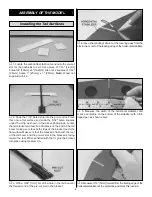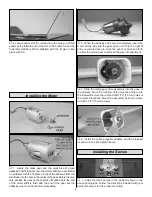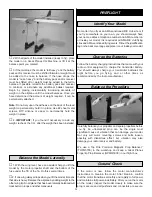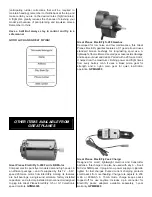
❏
2. With all parts of the model installed (ready to fly), place
the model on a Great Planes CG Machine, or lift it at the
balance point you marked.
❏
3. If the tail drops, the model is “tail heavy” and the battery
pack and/or receiver must be shifted forward or weight must
be added to the nose to balance. If the nose drops, the
model is “nose heavy” and the battery pack and/or receiver
must be shifted aft or weight must be added to the tail to
balance. If possible, relocate the battery pack and receiver
to minimize or eliminate any additional ballast required.
Begin by placing incrementally increasing amounts of
weight on the airplane until the model balances. Once you
have determined the amount of weight required, it can be
permanently attached.
Note: Do not rely upon the adhesive on the back of the lead
weight to permanently hold it in place. Use #2 sheet metal
screws, RTV silicone or epoxy to permanently hold the
weight in place.
❏
4. IMPORTANT: If you found it necessary to add any
weight, recheck the C.G. after the weight has been installed.
❏
1. With the wing level, have an assistant help you lift the
model by the motor propeller shaft and the bottom of the
fuse under the TE of the fin. Do this several times.
❏
2. If one wing always drops when you lift the model, it means
that side is heavy. Balance the airplane by adding weight to the
other wing tip. An airplane that has been laterally balanced will
track better in loops and other maneuvers.
No matter if you fly at an AMA sanctioned R/C club site or if
you fly somewhere on your own, you should always have
your name, address, telephone number and AMA number on
or inside your model. It is required at all AMA R/C club flying
sites and AMA sanctioned flying events. Fill out the identification
tag on the back cover page and place it on or inside your model.
Follow the battery charging instructions that came with your
radio control equipment to charge the transmitter battery.
You should always charge your transmitter batteries the
night before you go flying, and at other times as
recommended by the radio manufacturer.
Carefully balance your propeller and spare propellers before
you fly. An unbalanced prop can be the single most
significant cause of vibration that can damage your model.
Not only will motor mounting screws and bolts loosen,
possibly with disastrous effect, but vibration may also
damage your radio receiver and battery.
We use a Top Flite Precision Magnetic Prop Balancer
™
(TOPQ5700) in the workshop and keep a Great Planes
Fingertip Prop Balancer (GPMQ5000) in our flight box.
If the motor is new, follow the motor manufacturer’s
instructions to break-in the motor. After break-in, confirm
that the motor transitions smoothly and rapidly to full power
and maintains full power-indefinitely. After you run the motor
on the model, inspect the model closely to make sure the
prop is secure and all pushrods and connectors are secure.
Ground Check
Balance the Propellers
Charge the Batteries
Identify Your Model
PREFLIGHT
Balance the Model Laterally
13


































